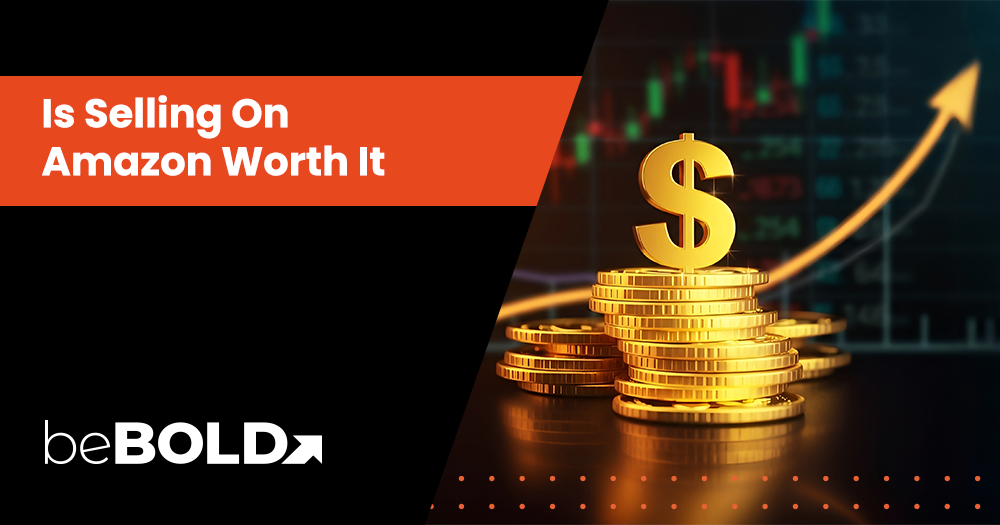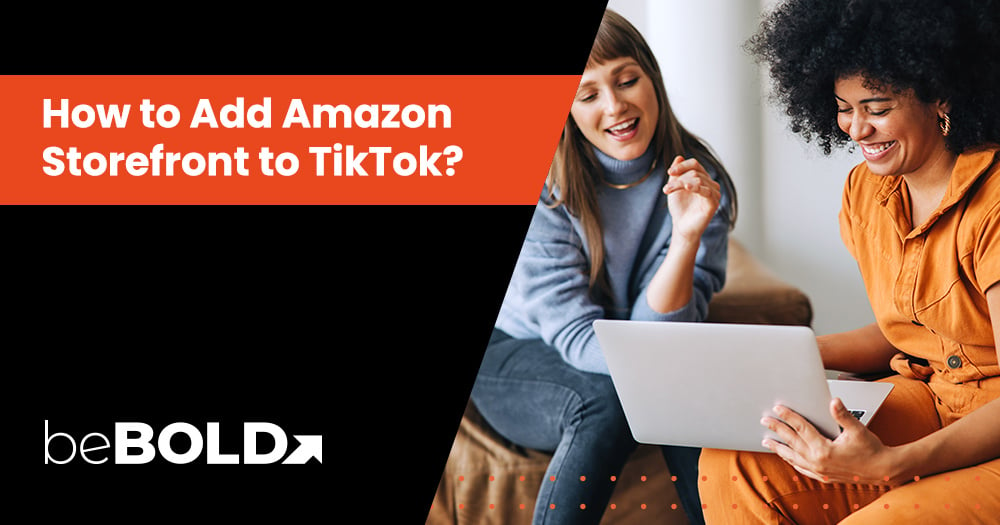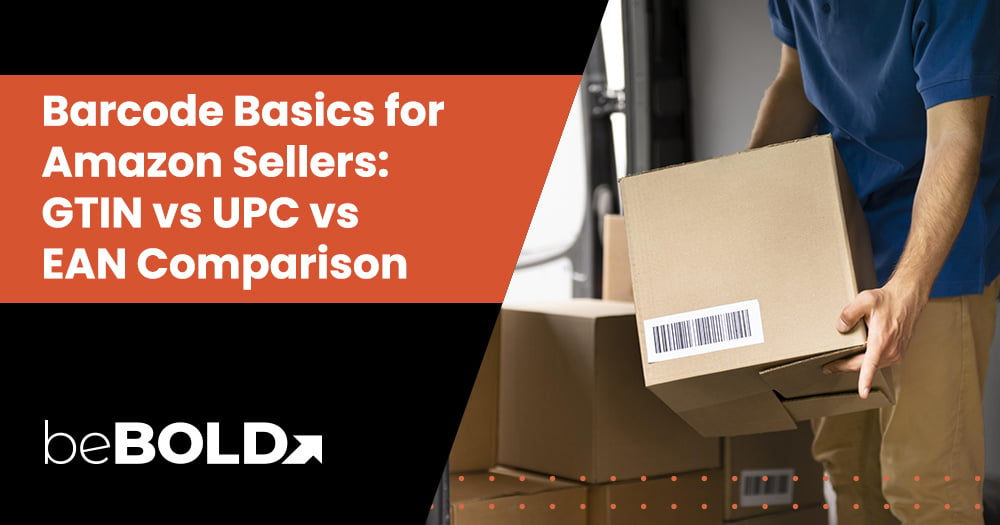The world of e-commerce is vast and constantly evolving, offering numerous opportunities for individuals and businesses to monetize their ideas, innovations, and products. One such opportunity lies in selling products on the Amazon marketplace. If done correctly, selling on Amazon can be an extremely profitable venture.
However, like any business, success isn't guaranteed, and it requires strategic planning, market research, and a clear understanding of the Amazon platform. Regardless, the most prevalent question among newbies is, "Is selling on Amazon worth it?"
This blog aims to investigate this question by presenting information on the basics of selling on Amazon, how much sellers can earn, using Amazon FBA to sell products, the fees associated with FBA, and much more to navigate the Amazon marketplace.
Selling Your Products on Amazon: The Basics

Before jumping into the main topic, let’s discuss the basics of selling on Amazon, which involves several steps to follow. This includes product listing, paid advertising, shipping, customer service, and brand registry. Let's now delve into them in detail.
1. Product Listing
A product listing on Amazon is your online storefront, showcasing details like features, pricing, and customer reviews. To create an effective listing, write a compelling title, provide a clear description, use high-quality images, and include relevant keywords.
But why all this? Well, a strong listing improves your visibility in Amazon's search engine and is essential for effective SEO strategies. Additionally, Amazon offers enhanced brand content (A+ Content), allowing sellers to create detailed descriptions with rich text, images, and comparison charts.
2. Paid Advertising
Paid advertising on Amazon helps you reach a broader audience by promoting your products beyond organic search.
Key ad types include:
- Sponsored Products: Keyword-targeted ads promoting individual Amazon product listings in search results and product pages.
- Sponsored Brands: Ads showcasing your brand and product portfolio, directing customers to your Amazon Store or custom landing page.
- Product Display Ads: Ads targeting customers viewing similar or complementary products.
3. Shipping
Focusing on shipping is vital for Amazon sellers, with options to either handle it yourself or use Amazon FBA for storage, packing, shipping, and customer service.
Here's a table to understand the shipping process better:
|
Shipping Options |
Fulfillment by Amazon (FBA) |
Fulfillment by Merchant (FBM) |
|
Storage |
Provided by Amazon |
Managed by the seller |
|
Packing + Shipping |
Handled by Amazon |
Handled by the seller |
|
Customer Service |
Provided by Amazon |
Managed by the seller |
Additionally, for international orders, ensure compliance with import regulations to avoid any hassle. Amazon's Global Shipping Program helps simplify international shipping.
4. Customer Service
Customer service is key to building trust and loyalty. With an Amazon FBA account, the platform handles customer inquiries, returns, and refunds, saving you time.
If managing service yourself under FBM, respond promptly and respectfully. All in all, an excellent service boosts reviews, ratings, and sales.
5. Brand Registry
Amazon's Brand Registry helps sellers protect and control their brands. It offers tools to manage listings, prevent infringements, and access features like A+ content, Sponsored Brand ads, and Storefronts.
Registering your brand is essential for protecting your products on Amazon
How Much Do Amazon Sellers Really Earn?

Amazon's vast customer base offers an enticing opportunity for substantial earnings. However, seller incomes can vary substantially.
Here's a table to understand better how much Amazon sellers earn:
|
Monthly Sales Range |
Percent of Sellers |
|
Under $500 |
31% |
|
$501 - $1,000 |
17% |
|
$1,001 - $5,000 |
22% |
|
$5,001 - $10,000 |
11% |
|
$10,001 - $25,000 |
7% |
|
$25,001 - $50,000 |
5% |
|
$50,001 - $100,000 |
4% |
|
$100,001 - $250,000 |
1% |
|
$251,000 - $500,000 |
1% |
What Can I sell on Amazon FBA?

Amazon FBA is a great service where Amazon handles storage, packaging, shipping, and customer service for sellers' products. It allows you to sell a wide range of items.
This includes categories like:
- Baby Products
- Books
- Clothing & Accessories
- Electronics
- Home & Garden
- Musical Instruments
- Office Products
- Sports
- Toys
However, some product categories require approval from Amazon before you can sell them.
These categories are called 'gated categories' and include:
- Automotive & Power sports
- Collectibles
- Fine Arts
- Grocery & Gourmet Food
- Jewelry
- Watches
What Are the Types of Amazon FBA Fees?
Selling on Amazon FBA comes with fees, which can vary based on the product category and whether you are using an Individual selling plan or a Professional Selling Plan.
Essential fees include a referral fee, a percentage of each sale, FBA fees for order fulfillment, storage fees for keeping your products in an Amazon fulfillment center, and a variable closing fee for media items.
If applicable, there may also be extra costs like long-term storage fees and removal order fees.
Amazon FBA Fees: Worth Paying or Better to Skip?
Deciding whether it's beneficial to pay Amazon's FBA fees depends on your specific business model and logistics needs. There are several factors associated with paying these fees. Let's look into them in detail in the following sections.
1. Time and effort
With FBA, Amazon handles storage, inventory, packing, shipping, and customer service, freeing up your time to focus on sourcing, marketing, and growing your business.
On the other hand, FBM gives you complete control over fulfillment but requires more time and effort, especially for large product ranges or high volumes. Deciding between the two depends on how much time and effort you're willing to invest in fulfillment.
2. Cost Factor
Cost is an essential factor when considering Amazon FBA for your business. While it simplifies fulfillment, there are fees to keep in mind, such as:
- Storage Fees: Based on the space your products occupy in Amazon's warehouses.
- Fulfillment Fees: Cover picking, packing, shipping, and handling returns.
- Removal Order Fees: Charged if products are stored too long or if you need to remove them.
- Referral and Closing Fees: Amazon charges referral fees and additional closing fees for each sale of media products.
3. Control Over Business
FBA allows you to tap into Amazon's robust infrastructure and vast customer base, but it means giving up some control over operations, branding, and customer interactions. While Amazon handles logistics and customer service, you'll need to follow their rules and won't have direct contact with customers.
Managing fulfillment in-house gives you more control and a personal connection with Amazon customers but requires more time and effort. Finding the right balance between control and Amazon's resources is key to maximizing success.
4. Sales volume Potential
FBA gives you access to Amazon's massive customer base, boosting your sales potential. By listing on Amazon and using FBA, your products become Prime-eligible, putting them in front of millions of dedicated Prime members.
This can significantly increase your sales compared to fulfilling orders yourself or relying on website traffic alone.
5. Shipping speed
FBA allows you to tap into Amazon's fast, free Prime shipping, delivering products to customers in as little as two days—sometimes even the same day.
This level of speed boosts customer satisfaction, leading to better reviews, repeat business, and referrals. It's a competitive edge that's hard to match when fulfilling orders on your own.
Is Amazon Too Saturated?
While Amazon is a crowded marketplace with fierce competition, it doesn't necessarily mean it's too saturated for new sellers. As online shopping grows, so does the demand for different products.
New and unique products, or even existing products with exceptional customer service or competitive pricing, can still achieve success on Amazon.
Therefore, while competition is a factor to keep in mind, it should encourage you to explore the opportunities offered by Amazon.
How Do I Stop People Ripping Off My Idea?
Protecting your business idea on a public marketplace like Amazon can be challenging. However, Amazon provides several tools to help brand owners protect their intellectual property.
By enrolling in Amazon's Brand Registry program, you receive more control over product listings featuring your trademarked brand, limiting the ability of others to sell counterfeit or knock-off versions of your products.
Additionally, consistently monitoring your listings, reporting potential infringements, and maintaining strong customer relationships can contribute to the protective shield around your products and business ideas.
What Are the Pros and Cons of Selling on Amazon?
Before embarking on an Amazon seller journey, weighing the pros and cons is essential. While there are endless benefits to selling on the marketplace, there are indeed some drawbacks. Let's get into them in detail.
Pros
- Built-in Reach: Selling on Amazon gives you access to millions of active users, with many customers starting their searches directly on Amazon, reducing marketing costs and boosting visibility.
- Trustworthy Platform: Amazon's reputation and secure payment process enhance customer confidence, making them more likely to buy from you, even if you're a new seller.
- Let FBA Handle Logistics: FBA manages storage, shipping, customer service, and returns, saving you time and resources. Plus, your products become Prime-eligible, attracting more customers and boosting brand reputation.
Cons
- Fierce Competition: Selling on Amazon comes with tough competition. With thousands of sellers, price wars and the battle for the Buy Box are common. Counterfeit products and competing with Amazon itself can also impact your sales and brand reputation.
- Limited Data Ownership: Selling on Amazon limits your access to customer data. Amazon controls customer relationships, making engaging in personal marketing or building long-term customer connections hard.
- Fees and Cost Considerations: Selling with FBA involves several fees, including referral, fulfillment, storage, and closing fees for media items. While FBA saves you warehousing costs, these fees can quickly add up, so understanding them is crucial for pricing strategy.
Is Selling on Amazon Profitable?
Selling on Amazon can indeed be profitable, but profitability isn't guaranteed. As with any business venture, it depends on several factors, including profit margin range.
Here’s a breakdown of Amazon seller profitability:
|
Profit Margin Range |
Percent of Sellers |
|
Less than 10% |
17% |
|
10% - 20% |
37% |
|
21% - 30% |
24% |
|
Over 30% |
20% |
|
Not Yet Profitable |
2% |
How to Build a Successful Amazon Business with FBA?
Achieving success as an Amazon FBA seller involves much more than listing your products. So, what does it take to build a successful business? Let's delve into it right away!
1. Optimizing Product Listings
Optimizing your product listing is crucial for boosting visibility and sales. Start with a compelling title with key search terms and a detailed product description. Use high-quality images and bullet points to highlight key features for easy readability. Incorporate relevant keywords to improve search rankings and enhance your chances of winning the Buy Box.
2. Effective Marketing Strategies
To boost your sales on Amazon, use effective marketing tactics. Sponsored Products ads can increase visibility through pay-per-click campaigns. Offer Amazon Coupons and run timed promotions to attract more customers. Social media marketing can help direct traffic to your Amazon listings, increasing your exposure.
3. Inventory Management
Proper inventory management ensures that you meet customer demand without overstocking. Utilize Amazon's FBA tools to track sales and plan inventory replenishment. Keep an eye on trends and seasonal demand to avoid stock-outs or excess inventory. Efficient inventory control helps maintain customer satisfaction and improves cash flow.
4. Pricing and Profitability Analysis
Set competitive prices by factoring in costs, competition, and market demand. Regularly analyze your profitability to ensure sustainable margins. When setting prices, consider Amazon fees, sourcing costs, and overheads. Regular pricing reviews help optimize profits and adjust to changes in the market.
Partner with beBold Digital to Build a Successful Amazon Business
In the journey to creating a thriving Amazon business, partnering with an expert marketing agency like beBold Digital is essential. beBold Digital specializes in critical areas like Brand Protection, Global Expansion, Amazon Ads, Amazon DSP, and driving incremental sales while ensuring sustainable profitability.
Our top priorities are helping our partners achieve consistent growth and maintain long-term success in a competitive marketplace. Ready to take your Amazon business to the next level? Schedule a call with us today to discuss how we can help!
Conclusion
Selling on Amazon, particularly through Amazon FBA, can be a profitable and worthwhile venture for businesses that plan and implement their strategies effectively. Amazon provides sellers with a vast customer base, including millions of potential customers, a reliable fulfillment process, and the potential for significant profits.
Nevertheless, like any business venture, it involves several challenges, and prospective sellers should consider solutions to deal with them efficiently. It's also important to remember that Amazon is just an avenue, and success on this platform, like any other, requires diligence, intelligent strategies, constant learning, and continuous adjustment to changing market dynamics.
Frequently Asked Questions
What are the requirements for starting to sell on Amazon?
To start selling on Amazon, you need to create an Amazon seller account, provide necessary business information, agree to the seller agreement, and complete Amazon's verification process. Once your account is set up, you can list products, choose a fulfillment method (FBA or FBM), and start selling.
Do I need a business license to sell on Amazon?
The need for a business license to sell on Amazon could depend on local laws in your area and the nature of your products. Although Amazon does not require a business license to create a seller account, you should check with local business registration authorities.
Should you just sell products at the cheapest price?
Selling products at the lowest price may not necessarily lead to profitability or business sustainability. Pricing should consider various factors, including costs, competition, desired profit margins, and customer price expectations. Adopting a competitive pricing strategy that ensures profitability is essential for business success.
How much initial investment is needed to sell on Amazon?
To start selling on Amazon, an initial investment of around $2000 to $5000 is typically needed for product sourcing, marketing, and other expenses. This investment can vary based on the type of products you sell and your business strategy.
Can you make a full-time income from selling on Amazon?
Yes, many sellers do make a full-time income from selling on Amazon. The platform's immense customer base and diverse markets provide ample opportunities for substantial earnings. However, it requires strategic planning, diligence, and continuous adaptation to market changes to achieve such success.
What are the drawbacks of selling on Amazon?
Potential drawbacks of selling on Amazon include intense competition, referral and fulfillment fees, restrictions on personal contact with shoppers, limited control over certain operations if using Amazon's fulfillment services, and the need to comply with Amazon's policies and guidelines, which can especially affect small businesses.
What are Amazon's advertising and marketing options?
Amazon offers sellers several advertising options, including Sponsored Products, Sponsored Brands, and Product Display Ads. These paid advertising methods enhance product visibility, attract traffic to your listings, and boost product sales. Sellers can also utilize promotions, deals, and coupons to attract customers.








Comments